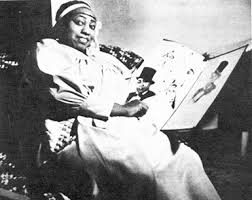
Gladys Bentley, in the Ebony article, showing off clippings from her career heyday.
Gladys Bentley, the model for the character Duchess Bentley in Speakeasy, enjoyed a terrific career as deliberately outrageous Lesbian nightclub singer during the Roaring Twenties, but saw her prospects plummet during the far less permissive Great Depression. Almost all homosexual entertainers saw the work dry up for them in the 1930s unless they adopted a public heterosexual front. Gladys Bentley however had been so outspoken about her Lesbianism, it was such a big part of her early success, that there was no escaping that public image which now became the main reason for her career downturn.
By the late 1940s Gladys Bentley’s performing career was practically non-existent. Meanwhile Red Scare paranoia not only raised fears against suspected Communists but was also the catalyst for a far greater witch hunt against homosexuals in Government jobs. It was during this time of particularly vicious public homophobia that Gladys Bentley published an article in Ebony magazine titled “I am a Woman Again” wherein she renounced Lesbianism, claiming she had taken hormone treatment to cure herself of this “strange affliction”. She was now married to a man and posed for numerous pictures showing her doing typical housework.


For the complete article go to this link
Whether this marriage was any more real than the Atlantic City marriage to a blond socialite Gladys bragged about two decades earlier is a matter of conjecture. The man in question later denied it ever took place, and even so, a year later the divorce was announced. Gladys later worked towards being ordained as a minister, but in 1960 died of the flu at the age of 52.

All the real life inspirations for major Speakeasy characters came to a “sticky end”. Julian Eltinge saw his ability to perform in drag greatly diminish with his career prospects and died in his early 40s, most likely due to alcoholism. Gene Malin died in a freak car crash when he was only 25, but at least he was still enjoying the peak of his career, and didn’t suffer the backlash against homosexual entertainers that lay just around the corner.
 Gladys Bentley’s fate however is to me the most shocking of the three. Her renouncement of her true nature, her turnaround from one of the most outspoken, literally out and proud lesbians of her day to making a grand public statement proclaiming herself cured from the disease of homosexuality, the desperation and pressure that must have lead her to such a decision, it is all horribly sad and tragic.
Gladys Bentley’s fate however is to me the most shocking of the three. Her renouncement of her true nature, her turnaround from one of the most outspoken, literally out and proud lesbians of her day to making a grand public statement proclaiming herself cured from the disease of homosexuality, the desperation and pressure that must have lead her to such a decision, it is all horribly sad and tragic.
So, just like in real life for Gladys Bentley, her Speakeasy counterpart Duchess “chooses” to marry a man after seeing her career and livelihood destroyed. Duchess Bentley marries, or is married to Reverend Fish. And she sings these lines in the opening of the song “Womanly”, lines that paraphrase Gladys Bentley’s own words in that infamous Ebony article:
DUCHESS:
FOR YEARS I LIVED A HALF-LIFE
DISDAINED THE GOODNESS OF MEN
MY HEART WAS CAST IN SHADOW
THEN I LEARNED TO LIVE ANEW
I CURED MY DEEP DARK SICKNESS
I AM A WOMAN AGAIN
I FOUND A MAN WHO LOVES ME
AND WHO I CAN LOVE TOO
Then Julian Carnation, himself forced by the Trial of the Tarts to reform himself as an inoffensive heterosexual crooner from the swishy female impersonator he once was, extols her now womanly perfections: “You are a paragon of Womanhood.”
Womanly (demo recording)
 This song attempts to illustrate how women have been trapped in cages of conformity to restrictive ideals of womanhood. The 1930s was a particularly difficult time for Lesbians, who saw all of the speakeasies closed that once catered to women who wanted to be with women. Not until the end of World War 2 would even one establishment covertly catering to Lesbians open again. As hard as it was for Gay Men to find another in the repressive 1930s, it was even more impossible for Lesbians. I wanted one song to describe this particular oppression of women. That “Womanly” has made so many women in the current company of Speakeasy distinctly uncomfortable is, I believe, a testament how well the song works to make its point. Nonetheless, for reasons of time, and because “Out of Sight” already so effectively illustrates Duchess Bentley’s comedown, “Womanly” has been cut from the current performance run of Speakeasy.
This song attempts to illustrate how women have been trapped in cages of conformity to restrictive ideals of womanhood. The 1930s was a particularly difficult time for Lesbians, who saw all of the speakeasies closed that once catered to women who wanted to be with women. Not until the end of World War 2 would even one establishment covertly catering to Lesbians open again. As hard as it was for Gay Men to find another in the repressive 1930s, it was even more impossible for Lesbians. I wanted one song to describe this particular oppression of women. That “Womanly” has made so many women in the current company of Speakeasy distinctly uncomfortable is, I believe, a testament how well the song works to make its point. Nonetheless, for reasons of time, and because “Out of Sight” already so effectively illustrates Duchess Bentley’s comedown, “Womanly” has been cut from the current performance run of Speakeasy.

Darcy Dunn, Bevin Bell-Hall, Anne Bragg, Allie Radice, Camille Atkinson and Dan Kelley performing “Womanly”

Good story 🙂
LikeLike
It’s a great song and a shame it had to be cut from the piece because of length.
LikeLiked by 1 person